Service Marketing Case Study: 7-Eleven's Success in the Taiwan Market
VerifiedAdded on 2023/06/11
|12
|3849
|270
Case Study
AI Summary
This case study examines 7-Eleven's service marketing strategies in Taiwan, focusing on its background, target market, marketing conditions, and the application of key service marketing principles. Initially founded in Dallas, 7-Eleven expanded to Taiwan, facing intense competition in the convenience store market. The company implemented strategic initiatives like partnering with China Trust Bank to enhance customer convenience through ATM services. Key service marketing theories, including post-purchase behavior, price theory, and viral marketing, are analyzed in the context of 7-Eleven's practices. The case study also evaluates the effectiveness of new service promotions, consumer persuasion, and other best practices, while identifying areas for improvement, such as avoiding personnel exploitation. The transformation of 7-Eleven into a self-service center through multimedia-inspired solutions and the 'ibon' system is highlighted as a significant success factor.
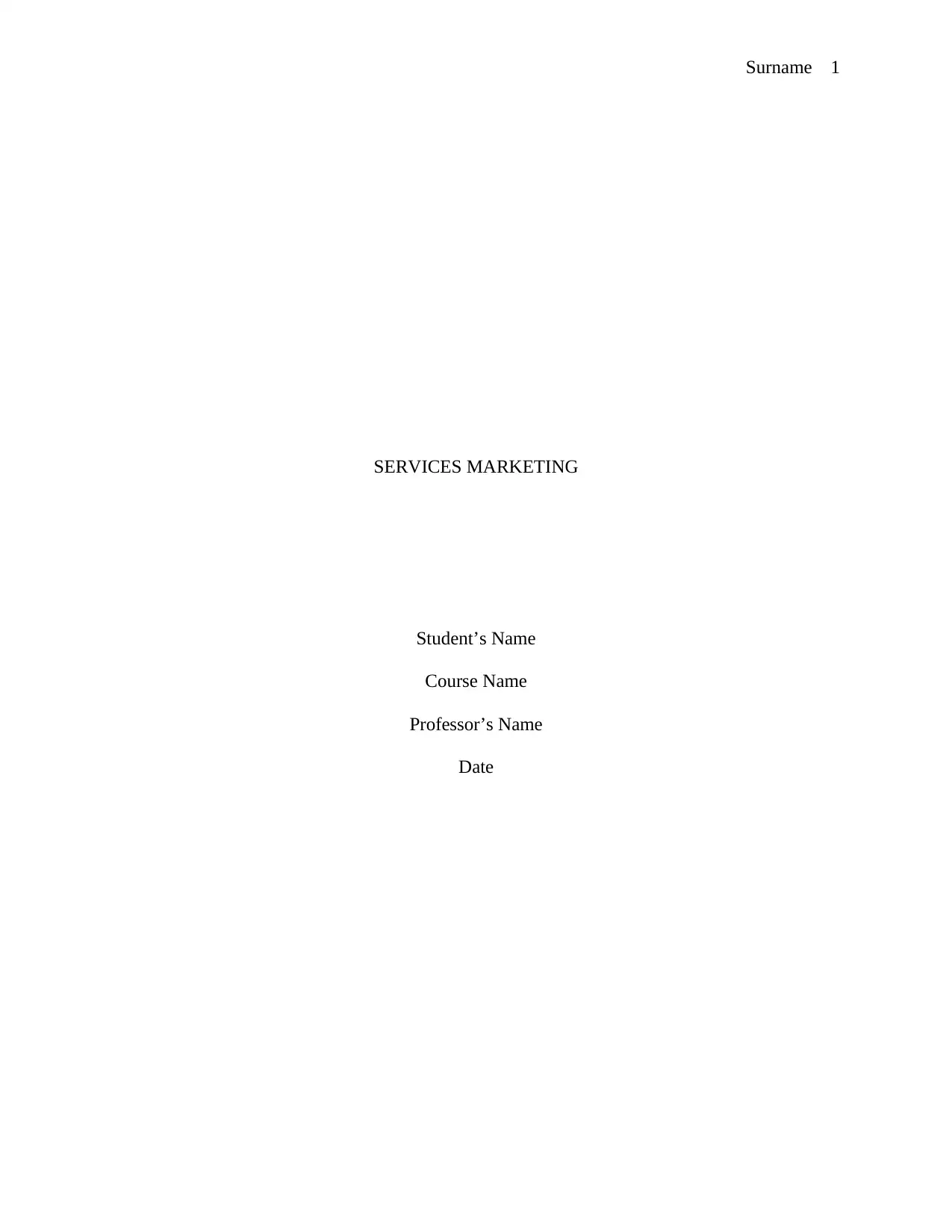
Surname 1
SERVICES MARKETING
Student’s Name
Course Name
Professor’s Name
Date
SERVICES MARKETING
Student’s Name
Course Name
Professor’s Name
Date
Paraphrase This Document
Need a fresh take? Get an instant paraphrase of this document with our AI Paraphraser

BACKGROUND ON THE BUSINESS
7-Eleven is an organization founded in Dallas, in 1927. This is the period when the
southland ice company began to sell staples such as eggs in the region, as well as milk and bread
in its different locations, for the convenience of its consumers. 1The organization was focused on
consumer convenience, especially the provision of commodities in hours when consumers cannot
access them from other organizations at different times. The organization further extended its
operations to 24 hours in a day, and seven days a week, to capture the target market. 7-Eleven
continued to grow to more distinguished convenience stores in locations within which it operated
especially during the nights and on weekends. 2The organization was also keen to distinguish
itself from the traditional supermarkets especially through its embracement of extended working
hours. International expansion strategy was also further looked into by the entity, which made it
a more famous entity in the region, and different parts of the world including Canada, Korea,
Thailand, and Taiwan in the modern business platform.
7-Eleven has more than 36400 stores outside the United States and continues to boast of
more profits. 3In the year 1980, the organization went ahead to open its first store in Taiwan, and
the location maximized its chances of being noticed by most drivers and the pedestrians in the
region. The product assortment strategy was adopted by 7-Eleven and managed to occupy one of
the best locations. However, the poor performance which was registered by the organization,
1 Armstrong, Gary, et al. Marketing: an introduction. Pearson Education, 2015.
2 Tu, C.-C., Yu, T., Patterson, P. G. & Liang, H.-M. “From convenience store to community service centre:
The transformation of Taiwan 7-Eleven”. In C. Lovelock, P. Patterson & J. Wirtz, Services marketing: An Asia-pacific
and Australian perspective (6th ed., pp. 439 443). Frenchs Forest, NSW: Pearson. (2015).
3Wirtz, Jochen, and Christopher Lovelock. "Services marketing." People, technology, strategy. Eighth
edition. New Jersey, London, Singapore, Beijing, Shanghai, Hong Kong, Taipei, Chennai, Tokyo: World Scientific.
Google Scholar(2016).
7-Eleven is an organization founded in Dallas, in 1927. This is the period when the
southland ice company began to sell staples such as eggs in the region, as well as milk and bread
in its different locations, for the convenience of its consumers. 1The organization was focused on
consumer convenience, especially the provision of commodities in hours when consumers cannot
access them from other organizations at different times. The organization further extended its
operations to 24 hours in a day, and seven days a week, to capture the target market. 7-Eleven
continued to grow to more distinguished convenience stores in locations within which it operated
especially during the nights and on weekends. 2The organization was also keen to distinguish
itself from the traditional supermarkets especially through its embracement of extended working
hours. International expansion strategy was also further looked into by the entity, which made it
a more famous entity in the region, and different parts of the world including Canada, Korea,
Thailand, and Taiwan in the modern business platform.
7-Eleven has more than 36400 stores outside the United States and continues to boast of
more profits. 3In the year 1980, the organization went ahead to open its first store in Taiwan, and
the location maximized its chances of being noticed by most drivers and the pedestrians in the
region. The product assortment strategy was adopted by 7-Eleven and managed to occupy one of
the best locations. However, the poor performance which was registered by the organization,
1 Armstrong, Gary, et al. Marketing: an introduction. Pearson Education, 2015.
2 Tu, C.-C., Yu, T., Patterson, P. G. & Liang, H.-M. “From convenience store to community service centre:
The transformation of Taiwan 7-Eleven”. In C. Lovelock, P. Patterson & J. Wirtz, Services marketing: An Asia-pacific
and Australian perspective (6th ed., pp. 439 443). Frenchs Forest, NSW: Pearson. (2015).
3Wirtz, Jochen, and Christopher Lovelock. "Services marketing." People, technology, strategy. Eighth
edition. New Jersey, London, Singapore, Beijing, Shanghai, Hong Kong, Taipei, Chennai, Tokyo: World Scientific.
Google Scholar(2016).
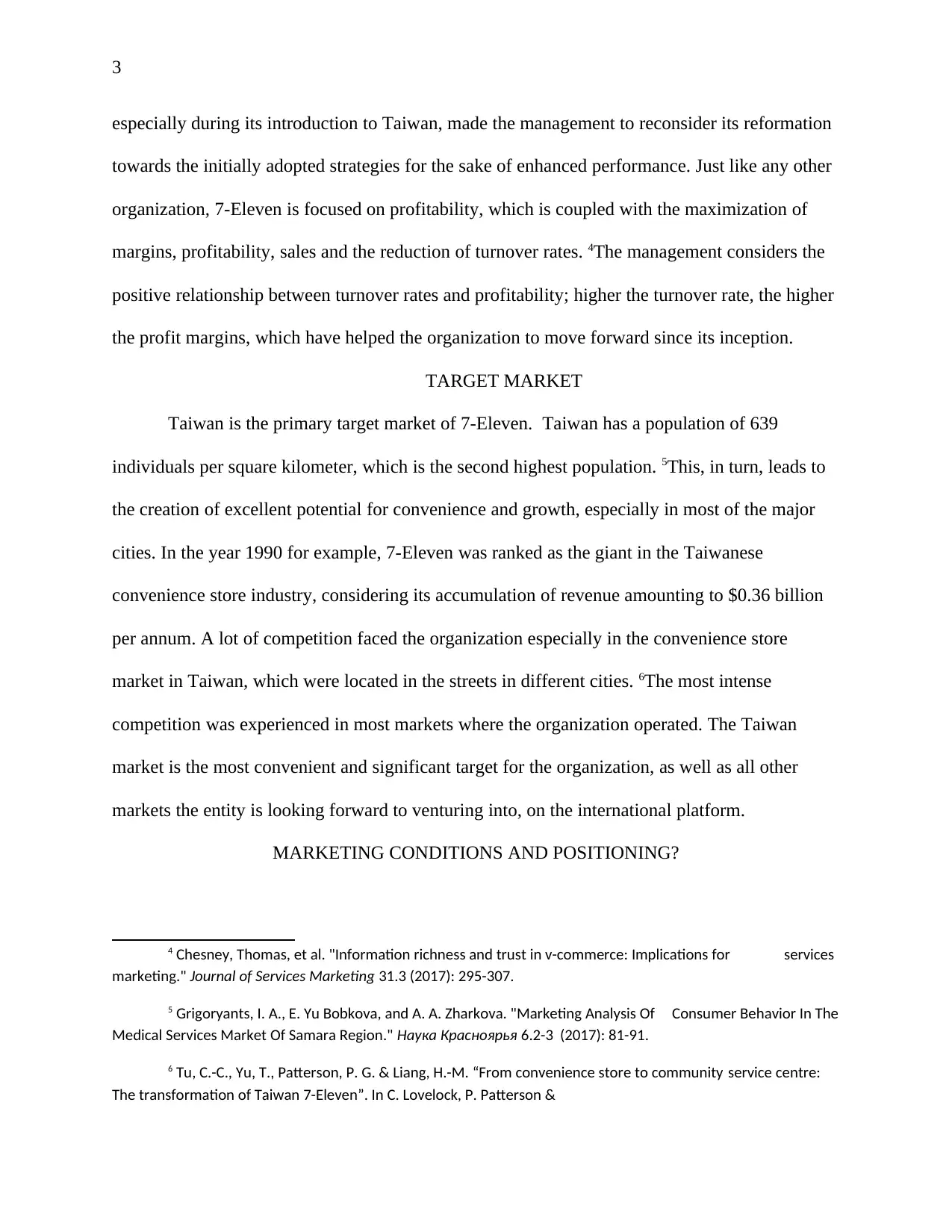
3
especially during its introduction to Taiwan, made the management to reconsider its reformation
towards the initially adopted strategies for the sake of enhanced performance. Just like any other
organization, 7-Eleven is focused on profitability, which is coupled with the maximization of
margins, profitability, sales and the reduction of turnover rates. 4The management considers the
positive relationship between turnover rates and profitability; higher the turnover rate, the higher
the profit margins, which have helped the organization to move forward since its inception.
TARGET MARKET
Taiwan is the primary target market of 7-Eleven. Taiwan has a population of 639
individuals per square kilometer, which is the second highest population. 5This, in turn, leads to
the creation of excellent potential for convenience and growth, especially in most of the major
cities. In the year 1990 for example, 7-Eleven was ranked as the giant in the Taiwanese
convenience store industry, considering its accumulation of revenue amounting to $0.36 billion
per annum. A lot of competition faced the organization especially in the convenience store
market in Taiwan, which were located in the streets in different cities. 6The most intense
competition was experienced in most markets where the organization operated. The Taiwan
market is the most convenient and significant target for the organization, as well as all other
markets the entity is looking forward to venturing into, on the international platform.
MARKETING CONDITIONS AND POSITIONING?
4 Chesney, Thomas, et al. "Information richness and trust in v-commerce: Implications for services
marketing." Journal of Services Marketing 31.3 (2017): 295-307.
5 Grigoryants, I. A., E. Yu Bobkova, and A. A. Zharkova. "Marketing Analysis Of Consumer Behavior In The
Medical Services Market Of Samara Region." Наука Красноярья 6.2-3 (2017): 81-91.
6 Tu, C.-C., Yu, T., Patterson, P. G. & Liang, H.-M. “From convenience store to community service centre:
The transformation of Taiwan 7-Eleven”. In C. Lovelock, P. Patterson &
especially during its introduction to Taiwan, made the management to reconsider its reformation
towards the initially adopted strategies for the sake of enhanced performance. Just like any other
organization, 7-Eleven is focused on profitability, which is coupled with the maximization of
margins, profitability, sales and the reduction of turnover rates. 4The management considers the
positive relationship between turnover rates and profitability; higher the turnover rate, the higher
the profit margins, which have helped the organization to move forward since its inception.
TARGET MARKET
Taiwan is the primary target market of 7-Eleven. Taiwan has a population of 639
individuals per square kilometer, which is the second highest population. 5This, in turn, leads to
the creation of excellent potential for convenience and growth, especially in most of the major
cities. In the year 1990 for example, 7-Eleven was ranked as the giant in the Taiwanese
convenience store industry, considering its accumulation of revenue amounting to $0.36 billion
per annum. A lot of competition faced the organization especially in the convenience store
market in Taiwan, which were located in the streets in different cities. 6The most intense
competition was experienced in most markets where the organization operated. The Taiwan
market is the most convenient and significant target for the organization, as well as all other
markets the entity is looking forward to venturing into, on the international platform.
MARKETING CONDITIONS AND POSITIONING?
4 Chesney, Thomas, et al. "Information richness and trust in v-commerce: Implications for services
marketing." Journal of Services Marketing 31.3 (2017): 295-307.
5 Grigoryants, I. A., E. Yu Bobkova, and A. A. Zharkova. "Marketing Analysis Of Consumer Behavior In The
Medical Services Market Of Samara Region." Наука Красноярья 6.2-3 (2017): 81-91.
6 Tu, C.-C., Yu, T., Patterson, P. G. & Liang, H.-M. “From convenience store to community service centre:
The transformation of Taiwan 7-Eleven”. In C. Lovelock, P. Patterson &
⊘ This is a preview!⊘
Do you want full access?
Subscribe today to unlock all pages.

Trusted by 1+ million students worldwide
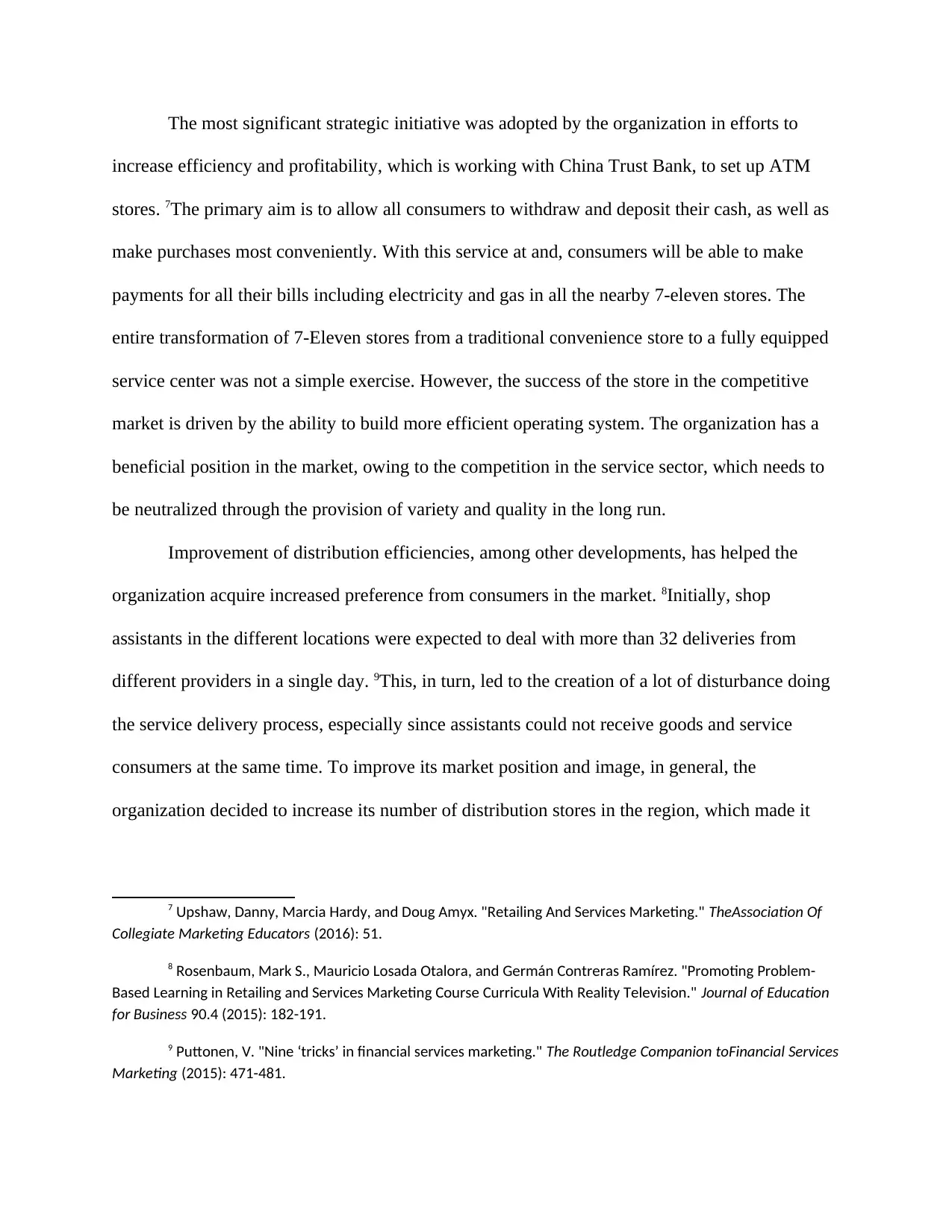
The most significant strategic initiative was adopted by the organization in efforts to
increase efficiency and profitability, which is working with China Trust Bank, to set up ATM
stores. 7The primary aim is to allow all consumers to withdraw and deposit their cash, as well as
make purchases most conveniently. With this service at and, consumers will be able to make
payments for all their bills including electricity and gas in all the nearby 7-eleven stores. The
entire transformation of 7-Eleven stores from a traditional convenience store to a fully equipped
service center was not a simple exercise. However, the success of the store in the competitive
market is driven by the ability to build more efficient operating system. The organization has a
beneficial position in the market, owing to the competition in the service sector, which needs to
be neutralized through the provision of variety and quality in the long run.
Improvement of distribution efficiencies, among other developments, has helped the
organization acquire increased preference from consumers in the market. 8Initially, shop
assistants in the different locations were expected to deal with more than 32 deliveries from
different providers in a single day. 9This, in turn, led to the creation of a lot of disturbance doing
the service delivery process, especially since assistants could not receive goods and service
consumers at the same time. To improve its market position and image, in general, the
organization decided to increase its number of distribution stores in the region, which made it
7 Upshaw, Danny, Marcia Hardy, and Doug Amyx. "Retailing And Services Marketing." TheAssociation Of
Collegiate Marketing Educators (2016): 51.
8 Rosenbaum, Mark S., Mauricio Losada Otalora, and Germán Contreras Ramírez. "Promoting Problem-
Based Learning in Retailing and Services Marketing Course Curricula With Reality Television." Journal of Education
for Business 90.4 (2015): 182-191.
9 Puttonen, V. "Nine ‘tricks’ in financial services marketing." The Routledge Companion toFinancial Services
Marketing (2015): 471-481.
increase efficiency and profitability, which is working with China Trust Bank, to set up ATM
stores. 7The primary aim is to allow all consumers to withdraw and deposit their cash, as well as
make purchases most conveniently. With this service at and, consumers will be able to make
payments for all their bills including electricity and gas in all the nearby 7-eleven stores. The
entire transformation of 7-Eleven stores from a traditional convenience store to a fully equipped
service center was not a simple exercise. However, the success of the store in the competitive
market is driven by the ability to build more efficient operating system. The organization has a
beneficial position in the market, owing to the competition in the service sector, which needs to
be neutralized through the provision of variety and quality in the long run.
Improvement of distribution efficiencies, among other developments, has helped the
organization acquire increased preference from consumers in the market. 8Initially, shop
assistants in the different locations were expected to deal with more than 32 deliveries from
different providers in a single day. 9This, in turn, led to the creation of a lot of disturbance doing
the service delivery process, especially since assistants could not receive goods and service
consumers at the same time. To improve its market position and image, in general, the
organization decided to increase its number of distribution stores in the region, which made it
7 Upshaw, Danny, Marcia Hardy, and Doug Amyx. "Retailing And Services Marketing." TheAssociation Of
Collegiate Marketing Educators (2016): 51.
8 Rosenbaum, Mark S., Mauricio Losada Otalora, and Germán Contreras Ramírez. "Promoting Problem-
Based Learning in Retailing and Services Marketing Course Curricula With Reality Television." Journal of Education
for Business 90.4 (2015): 182-191.
9 Puttonen, V. "Nine ‘tricks’ in financial services marketing." The Routledge Companion toFinancial Services
Marketing (2015): 471-481.
Paraphrase This Document
Need a fresh take? Get an instant paraphrase of this document with our AI Paraphraser
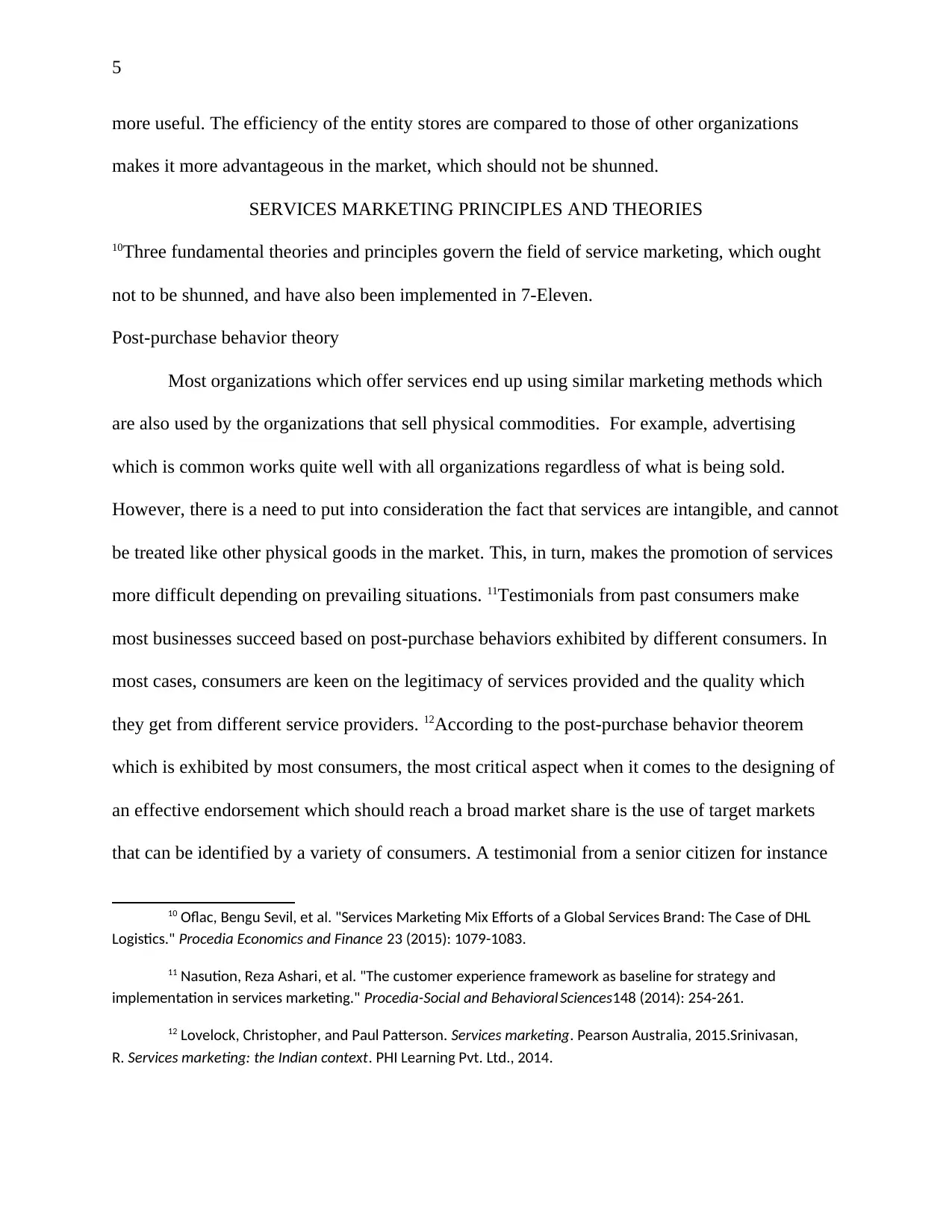
5
more useful. The efficiency of the entity stores are compared to those of other organizations
makes it more advantageous in the market, which should not be shunned.
SERVICES MARKETING PRINCIPLES AND THEORIES
10Three fundamental theories and principles govern the field of service marketing, which ought
not to be shunned, and have also been implemented in 7-Eleven.
Post-purchase behavior theory
Most organizations which offer services end up using similar marketing methods which
are also used by the organizations that sell physical commodities. For example, advertising
which is common works quite well with all organizations regardless of what is being sold.
However, there is a need to put into consideration the fact that services are intangible, and cannot
be treated like other physical goods in the market. This, in turn, makes the promotion of services
more difficult depending on prevailing situations. 11Testimonials from past consumers make
most businesses succeed based on post-purchase behaviors exhibited by different consumers. In
most cases, consumers are keen on the legitimacy of services provided and the quality which
they get from different service providers. 12According to the post-purchase behavior theorem
which is exhibited by most consumers, the most critical aspect when it comes to the designing of
an effective endorsement which should reach a broad market share is the use of target markets
that can be identified by a variety of consumers. A testimonial from a senior citizen for instance
10 Oflac, Bengu Sevil, et al. "Services Marketing Mix Efforts of a Global Services Brand: The Case of DHL
Logistics." Procedia Economics and Finance 23 (2015): 1079-1083.
11 Nasution, Reza Ashari, et al. "The customer experience framework as baseline for strategy and
implementation in services marketing." Procedia-Social and Behavioral Sciences148 (2014): 254-261.
12 Lovelock, Christopher, and Paul Patterson. Services marketing. Pearson Australia, 2015.Srinivasan,
R. Services marketing: the Indian context. PHI Learning Pvt. Ltd., 2014.
more useful. The efficiency of the entity stores are compared to those of other organizations
makes it more advantageous in the market, which should not be shunned.
SERVICES MARKETING PRINCIPLES AND THEORIES
10Three fundamental theories and principles govern the field of service marketing, which ought
not to be shunned, and have also been implemented in 7-Eleven.
Post-purchase behavior theory
Most organizations which offer services end up using similar marketing methods which
are also used by the organizations that sell physical commodities. For example, advertising
which is common works quite well with all organizations regardless of what is being sold.
However, there is a need to put into consideration the fact that services are intangible, and cannot
be treated like other physical goods in the market. This, in turn, makes the promotion of services
more difficult depending on prevailing situations. 11Testimonials from past consumers make
most businesses succeed based on post-purchase behaviors exhibited by different consumers. In
most cases, consumers are keen on the legitimacy of services provided and the quality which
they get from different service providers. 12According to the post-purchase behavior theorem
which is exhibited by most consumers, the most critical aspect when it comes to the designing of
an effective endorsement which should reach a broad market share is the use of target markets
that can be identified by a variety of consumers. A testimonial from a senior citizen for instance
10 Oflac, Bengu Sevil, et al. "Services Marketing Mix Efforts of a Global Services Brand: The Case of DHL
Logistics." Procedia Economics and Finance 23 (2015): 1079-1083.
11 Nasution, Reza Ashari, et al. "The customer experience framework as baseline for strategy and
implementation in services marketing." Procedia-Social and Behavioral Sciences148 (2014): 254-261.
12 Lovelock, Christopher, and Paul Patterson. Services marketing. Pearson Australia, 2015.Srinivasan,
R. Services marketing: the Indian context. PHI Learning Pvt. Ltd., 2014.
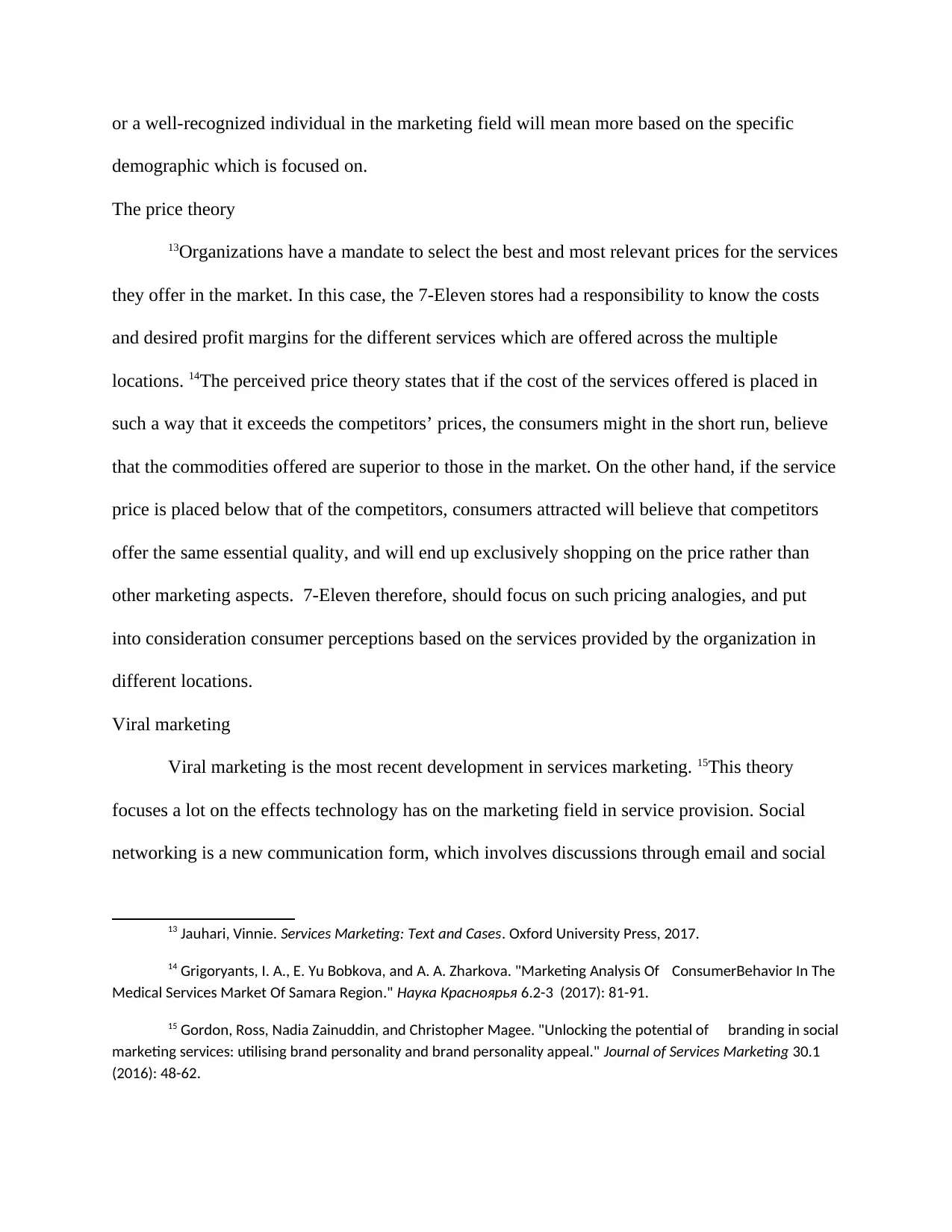
or a well-recognized individual in the marketing field will mean more based on the specific
demographic which is focused on.
The price theory
13Organizations have a mandate to select the best and most relevant prices for the services
they offer in the market. In this case, the 7-Eleven stores had a responsibility to know the costs
and desired profit margins for the different services which are offered across the multiple
locations. 14The perceived price theory states that if the cost of the services offered is placed in
such a way that it exceeds the competitors’ prices, the consumers might in the short run, believe
that the commodities offered are superior to those in the market. On the other hand, if the service
price is placed below that of the competitors, consumers attracted will believe that competitors
offer the same essential quality, and will end up exclusively shopping on the price rather than
other marketing aspects. 7-Eleven therefore, should focus on such pricing analogies, and put
into consideration consumer perceptions based on the services provided by the organization in
different locations.
Viral marketing
Viral marketing is the most recent development in services marketing. 15This theory
focuses a lot on the effects technology has on the marketing field in service provision. Social
networking is a new communication form, which involves discussions through email and social
13 Jauhari, Vinnie. Services Marketing: Text and Cases. Oxford University Press, 2017.
14 Grigoryants, I. A., E. Yu Bobkova, and A. A. Zharkova. "Marketing Analysis Of ConsumerBehavior In The
Medical Services Market Of Samara Region." Наука Красноярья 6.2-3 (2017): 81-91.
15 Gordon, Ross, Nadia Zainuddin, and Christopher Magee. "Unlocking the potential of branding in social
marketing services: utilising brand personality and brand personality appeal." Journal of Services Marketing 30.1
(2016): 48-62.
demographic which is focused on.
The price theory
13Organizations have a mandate to select the best and most relevant prices for the services
they offer in the market. In this case, the 7-Eleven stores had a responsibility to know the costs
and desired profit margins for the different services which are offered across the multiple
locations. 14The perceived price theory states that if the cost of the services offered is placed in
such a way that it exceeds the competitors’ prices, the consumers might in the short run, believe
that the commodities offered are superior to those in the market. On the other hand, if the service
price is placed below that of the competitors, consumers attracted will believe that competitors
offer the same essential quality, and will end up exclusively shopping on the price rather than
other marketing aspects. 7-Eleven therefore, should focus on such pricing analogies, and put
into consideration consumer perceptions based on the services provided by the organization in
different locations.
Viral marketing
Viral marketing is the most recent development in services marketing. 15This theory
focuses a lot on the effects technology has on the marketing field in service provision. Social
networking is a new communication form, which involves discussions through email and social
13 Jauhari, Vinnie. Services Marketing: Text and Cases. Oxford University Press, 2017.
14 Grigoryants, I. A., E. Yu Bobkova, and A. A. Zharkova. "Marketing Analysis Of ConsumerBehavior In The
Medical Services Market Of Samara Region." Наука Красноярья 6.2-3 (2017): 81-91.
15 Gordon, Ross, Nadia Zainuddin, and Christopher Magee. "Unlocking the potential of branding in social
marketing services: utilising brand personality and brand personality appeal." Journal of Services Marketing 30.1
(2016): 48-62.
⊘ This is a preview!⊘
Do you want full access?
Subscribe today to unlock all pages.

Trusted by 1+ million students worldwide
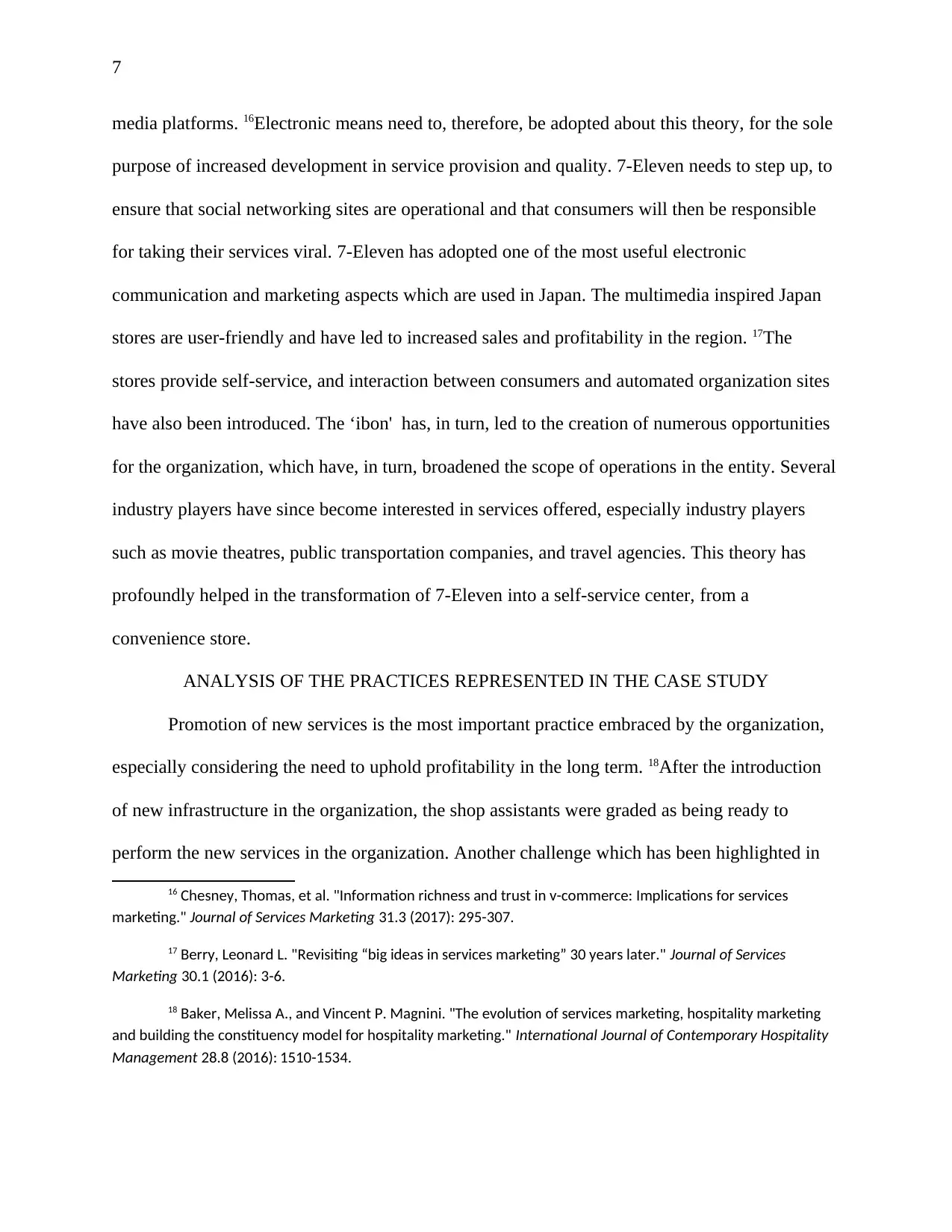
7
media platforms. 16Electronic means need to, therefore, be adopted about this theory, for the sole
purpose of increased development in service provision and quality. 7-Eleven needs to step up, to
ensure that social networking sites are operational and that consumers will then be responsible
for taking their services viral. 7-Eleven has adopted one of the most useful electronic
communication and marketing aspects which are used in Japan. The multimedia inspired Japan
stores are user-friendly and have led to increased sales and profitability in the region. 17The
stores provide self-service, and interaction between consumers and automated organization sites
have also been introduced. The ‘ibon' has, in turn, led to the creation of numerous opportunities
for the organization, which have, in turn, broadened the scope of operations in the entity. Several
industry players have since become interested in services offered, especially industry players
such as movie theatres, public transportation companies, and travel agencies. This theory has
profoundly helped in the transformation of 7-Eleven into a self-service center, from a
convenience store.
ANALYSIS OF THE PRACTICES REPRESENTED IN THE CASE STUDY
Promotion of new services is the most important practice embraced by the organization,
especially considering the need to uphold profitability in the long term. 18After the introduction
of new infrastructure in the organization, the shop assistants were graded as being ready to
perform the new services in the organization. Another challenge which has been highlighted in
16 Chesney, Thomas, et al. "Information richness and trust in v-commerce: Implications for services
marketing." Journal of Services Marketing 31.3 (2017): 295-307.
17 Berry, Leonard L. "Revisiting “big ideas in services marketing” 30 years later." Journal of Services
Marketing 30.1 (2016): 3-6.
18 Baker, Melissa A., and Vincent P. Magnini. "The evolution of services marketing, hospitality marketing
and building the constituency model for hospitality marketing." International Journal of Contemporary Hospitality
Management 28.8 (2016): 1510-1534.
media platforms. 16Electronic means need to, therefore, be adopted about this theory, for the sole
purpose of increased development in service provision and quality. 7-Eleven needs to step up, to
ensure that social networking sites are operational and that consumers will then be responsible
for taking their services viral. 7-Eleven has adopted one of the most useful electronic
communication and marketing aspects which are used in Japan. The multimedia inspired Japan
stores are user-friendly and have led to increased sales and profitability in the region. 17The
stores provide self-service, and interaction between consumers and automated organization sites
have also been introduced. The ‘ibon' has, in turn, led to the creation of numerous opportunities
for the organization, which have, in turn, broadened the scope of operations in the entity. Several
industry players have since become interested in services offered, especially industry players
such as movie theatres, public transportation companies, and travel agencies. This theory has
profoundly helped in the transformation of 7-Eleven into a self-service center, from a
convenience store.
ANALYSIS OF THE PRACTICES REPRESENTED IN THE CASE STUDY
Promotion of new services is the most important practice embraced by the organization,
especially considering the need to uphold profitability in the long term. 18After the introduction
of new infrastructure in the organization, the shop assistants were graded as being ready to
perform the new services in the organization. Another challenge which has been highlighted in
16 Chesney, Thomas, et al. "Information richness and trust in v-commerce: Implications for services
marketing." Journal of Services Marketing 31.3 (2017): 295-307.
17 Berry, Leonard L. "Revisiting “big ideas in services marketing” 30 years later." Journal of Services
Marketing 30.1 (2016): 3-6.
18 Baker, Melissa A., and Vincent P. Magnini. "The evolution of services marketing, hospitality marketing
and building the constituency model for hospitality marketing." International Journal of Contemporary Hospitality
Management 28.8 (2016): 1510-1534.
Paraphrase This Document
Need a fresh take? Get an instant paraphrase of this document with our AI Paraphraser
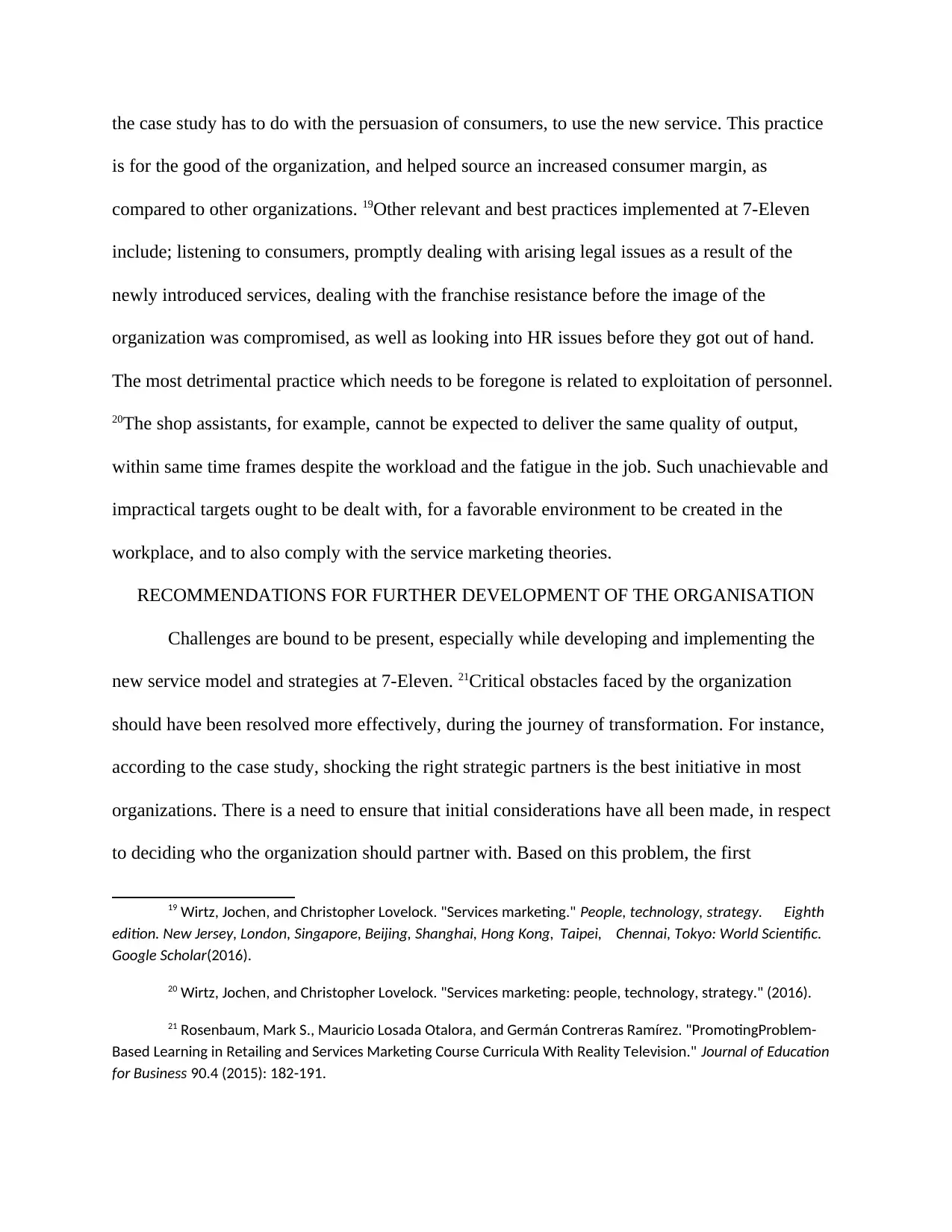
the case study has to do with the persuasion of consumers, to use the new service. This practice
is for the good of the organization, and helped source an increased consumer margin, as
compared to other organizations. 19Other relevant and best practices implemented at 7-Eleven
include; listening to consumers, promptly dealing with arising legal issues as a result of the
newly introduced services, dealing with the franchise resistance before the image of the
organization was compromised, as well as looking into HR issues before they got out of hand.
The most detrimental practice which needs to be foregone is related to exploitation of personnel.
20The shop assistants, for example, cannot be expected to deliver the same quality of output,
within same time frames despite the workload and the fatigue in the job. Such unachievable and
impractical targets ought to be dealt with, for a favorable environment to be created in the
workplace, and to also comply with the service marketing theories.
RECOMMENDATIONS FOR FURTHER DEVELOPMENT OF THE ORGANISATION
Challenges are bound to be present, especially while developing and implementing the
new service model and strategies at 7-Eleven. 21Critical obstacles faced by the organization
should have been resolved more effectively, during the journey of transformation. For instance,
according to the case study, shocking the right strategic partners is the best initiative in most
organizations. There is a need to ensure that initial considerations have all been made, in respect
to deciding who the organization should partner with. Based on this problem, the first
19 Wirtz, Jochen, and Christopher Lovelock. "Services marketing." People, technology, strategy. Eighth
edition. New Jersey, London, Singapore, Beijing, Shanghai, Hong Kong, Taipei, Chennai, Tokyo: World Scientific.
Google Scholar(2016).
20 Wirtz, Jochen, and Christopher Lovelock. "Services marketing: people, technology, strategy." (2016).
21 Rosenbaum, Mark S., Mauricio Losada Otalora, and Germán Contreras Ramírez. "PromotingProblem-
Based Learning in Retailing and Services Marketing Course Curricula With Reality Television." Journal of Education
for Business 90.4 (2015): 182-191.
is for the good of the organization, and helped source an increased consumer margin, as
compared to other organizations. 19Other relevant and best practices implemented at 7-Eleven
include; listening to consumers, promptly dealing with arising legal issues as a result of the
newly introduced services, dealing with the franchise resistance before the image of the
organization was compromised, as well as looking into HR issues before they got out of hand.
The most detrimental practice which needs to be foregone is related to exploitation of personnel.
20The shop assistants, for example, cannot be expected to deliver the same quality of output,
within same time frames despite the workload and the fatigue in the job. Such unachievable and
impractical targets ought to be dealt with, for a favorable environment to be created in the
workplace, and to also comply with the service marketing theories.
RECOMMENDATIONS FOR FURTHER DEVELOPMENT OF THE ORGANISATION
Challenges are bound to be present, especially while developing and implementing the
new service model and strategies at 7-Eleven. 21Critical obstacles faced by the organization
should have been resolved more effectively, during the journey of transformation. For instance,
according to the case study, shocking the right strategic partners is the best initiative in most
organizations. There is a need to ensure that initial considerations have all been made, in respect
to deciding who the organization should partner with. Based on this problem, the first
19 Wirtz, Jochen, and Christopher Lovelock. "Services marketing." People, technology, strategy. Eighth
edition. New Jersey, London, Singapore, Beijing, Shanghai, Hong Kong, Taipei, Chennai, Tokyo: World Scientific.
Google Scholar(2016).
20 Wirtz, Jochen, and Christopher Lovelock. "Services marketing: people, technology, strategy." (2016).
21 Rosenbaum, Mark S., Mauricio Losada Otalora, and Germán Contreras Ramírez. "PromotingProblem-
Based Learning in Retailing and Services Marketing Course Curricula With Reality Television." Journal of Education
for Business 90.4 (2015): 182-191.
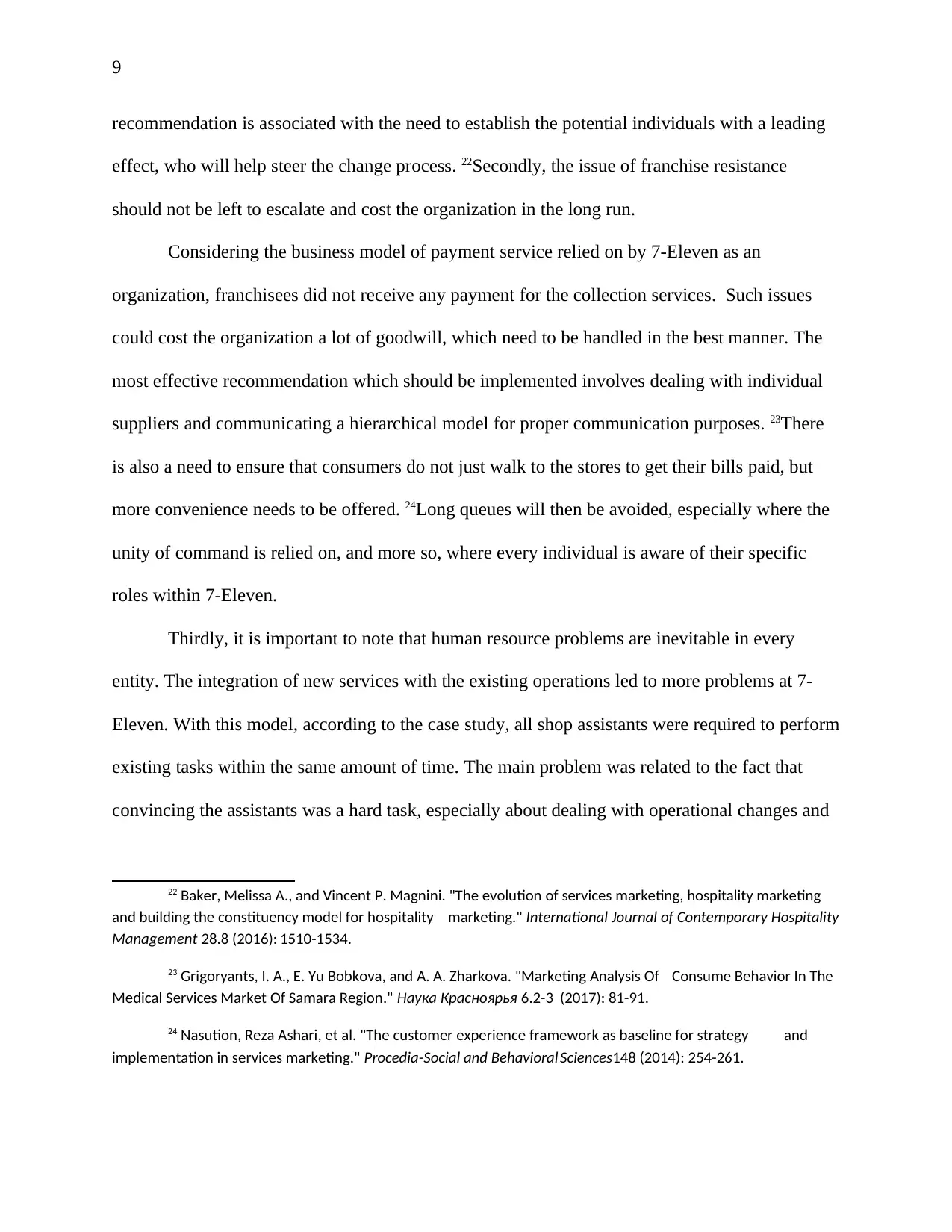
9
recommendation is associated with the need to establish the potential individuals with a leading
effect, who will help steer the change process. 22Secondly, the issue of franchise resistance
should not be left to escalate and cost the organization in the long run.
Considering the business model of payment service relied on by 7-Eleven as an
organization, franchisees did not receive any payment for the collection services. Such issues
could cost the organization a lot of goodwill, which need to be handled in the best manner. The
most effective recommendation which should be implemented involves dealing with individual
suppliers and communicating a hierarchical model for proper communication purposes. 23There
is also a need to ensure that consumers do not just walk to the stores to get their bills paid, but
more convenience needs to be offered. 24Long queues will then be avoided, especially where the
unity of command is relied on, and more so, where every individual is aware of their specific
roles within 7-Eleven.
Thirdly, it is important to note that human resource problems are inevitable in every
entity. The integration of new services with the existing operations led to more problems at 7-
Eleven. With this model, according to the case study, all shop assistants were required to perform
existing tasks within the same amount of time. The main problem was related to the fact that
convincing the assistants was a hard task, especially about dealing with operational changes and
22 Baker, Melissa A., and Vincent P. Magnini. "The evolution of services marketing, hospitality marketing
and building the constituency model for hospitality marketing." International Journal of Contemporary Hospitality
Management 28.8 (2016): 1510-1534.
23 Grigoryants, I. A., E. Yu Bobkova, and A. A. Zharkova. "Marketing Analysis Of Consume Behavior In The
Medical Services Market Of Samara Region." Наука Красноярья 6.2-3 (2017): 81-91.
24 Nasution, Reza Ashari, et al. "The customer experience framework as baseline for strategy and
implementation in services marketing." Procedia-Social and Behavioral Sciences148 (2014): 254-261.
recommendation is associated with the need to establish the potential individuals with a leading
effect, who will help steer the change process. 22Secondly, the issue of franchise resistance
should not be left to escalate and cost the organization in the long run.
Considering the business model of payment service relied on by 7-Eleven as an
organization, franchisees did not receive any payment for the collection services. Such issues
could cost the organization a lot of goodwill, which need to be handled in the best manner. The
most effective recommendation which should be implemented involves dealing with individual
suppliers and communicating a hierarchical model for proper communication purposes. 23There
is also a need to ensure that consumers do not just walk to the stores to get their bills paid, but
more convenience needs to be offered. 24Long queues will then be avoided, especially where the
unity of command is relied on, and more so, where every individual is aware of their specific
roles within 7-Eleven.
Thirdly, it is important to note that human resource problems are inevitable in every
entity. The integration of new services with the existing operations led to more problems at 7-
Eleven. With this model, according to the case study, all shop assistants were required to perform
existing tasks within the same amount of time. The main problem was related to the fact that
convincing the assistants was a hard task, especially about dealing with operational changes and
22 Baker, Melissa A., and Vincent P. Magnini. "The evolution of services marketing, hospitality marketing
and building the constituency model for hospitality marketing." International Journal of Contemporary Hospitality
Management 28.8 (2016): 1510-1534.
23 Grigoryants, I. A., E. Yu Bobkova, and A. A. Zharkova. "Marketing Analysis Of Consume Behavior In The
Medical Services Market Of Samara Region." Наука Красноярья 6.2-3 (2017): 81-91.
24 Nasution, Reza Ashari, et al. "The customer experience framework as baseline for strategy and
implementation in services marketing." Procedia-Social and Behavioral Sciences148 (2014): 254-261.
⊘ This is a preview!⊘
Do you want full access?
Subscribe today to unlock all pages.

Trusted by 1+ million students worldwide
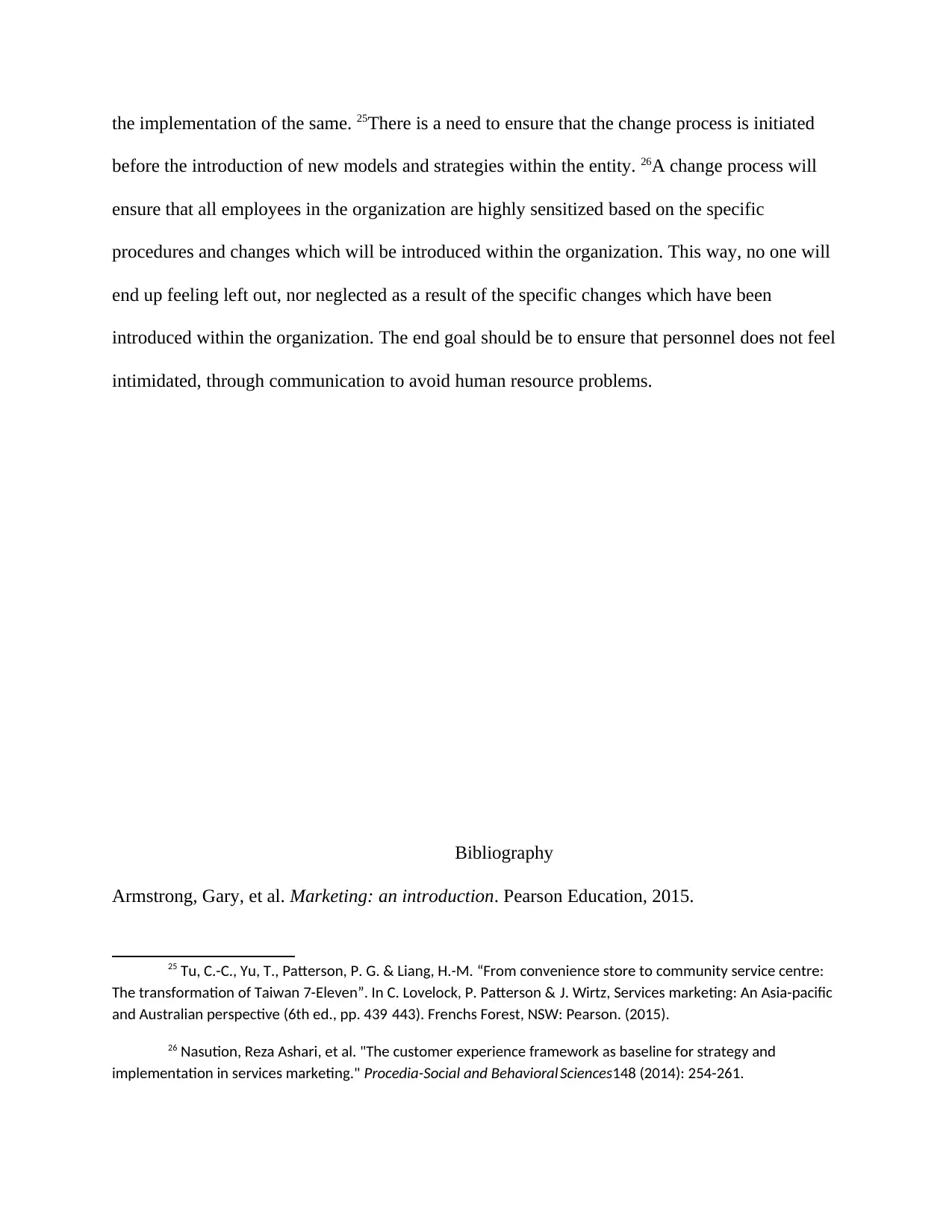
the implementation of the same. 25There is a need to ensure that the change process is initiated
before the introduction of new models and strategies within the entity. 26A change process will
ensure that all employees in the organization are highly sensitized based on the specific
procedures and changes which will be introduced within the organization. This way, no one will
end up feeling left out, nor neglected as a result of the specific changes which have been
introduced within the organization. The end goal should be to ensure that personnel does not feel
intimidated, through communication to avoid human resource problems.
Bibliography
Armstrong, Gary, et al. Marketing: an introduction. Pearson Education, 2015.
25 Tu, C.-C., Yu, T., Patterson, P. G. & Liang, H.-M. “From convenience store to community service centre:
The transformation of Taiwan 7-Eleven”. In C. Lovelock, P. Patterson & J. Wirtz, Services marketing: An Asia-pacific
and Australian perspective (6th ed., pp. 439 443). Frenchs Forest, NSW: Pearson. (2015).
26 Nasution, Reza Ashari, et al. "The customer experience framework as baseline for strategy and
implementation in services marketing." Procedia-Social and Behavioral Sciences148 (2014): 254-261.
before the introduction of new models and strategies within the entity. 26A change process will
ensure that all employees in the organization are highly sensitized based on the specific
procedures and changes which will be introduced within the organization. This way, no one will
end up feeling left out, nor neglected as a result of the specific changes which have been
introduced within the organization. The end goal should be to ensure that personnel does not feel
intimidated, through communication to avoid human resource problems.
Bibliography
Armstrong, Gary, et al. Marketing: an introduction. Pearson Education, 2015.
25 Tu, C.-C., Yu, T., Patterson, P. G. & Liang, H.-M. “From convenience store to community service centre:
The transformation of Taiwan 7-Eleven”. In C. Lovelock, P. Patterson & J. Wirtz, Services marketing: An Asia-pacific
and Australian perspective (6th ed., pp. 439 443). Frenchs Forest, NSW: Pearson. (2015).
26 Nasution, Reza Ashari, et al. "The customer experience framework as baseline for strategy and
implementation in services marketing." Procedia-Social and Behavioral Sciences148 (2014): 254-261.
Paraphrase This Document
Need a fresh take? Get an instant paraphrase of this document with our AI Paraphraser
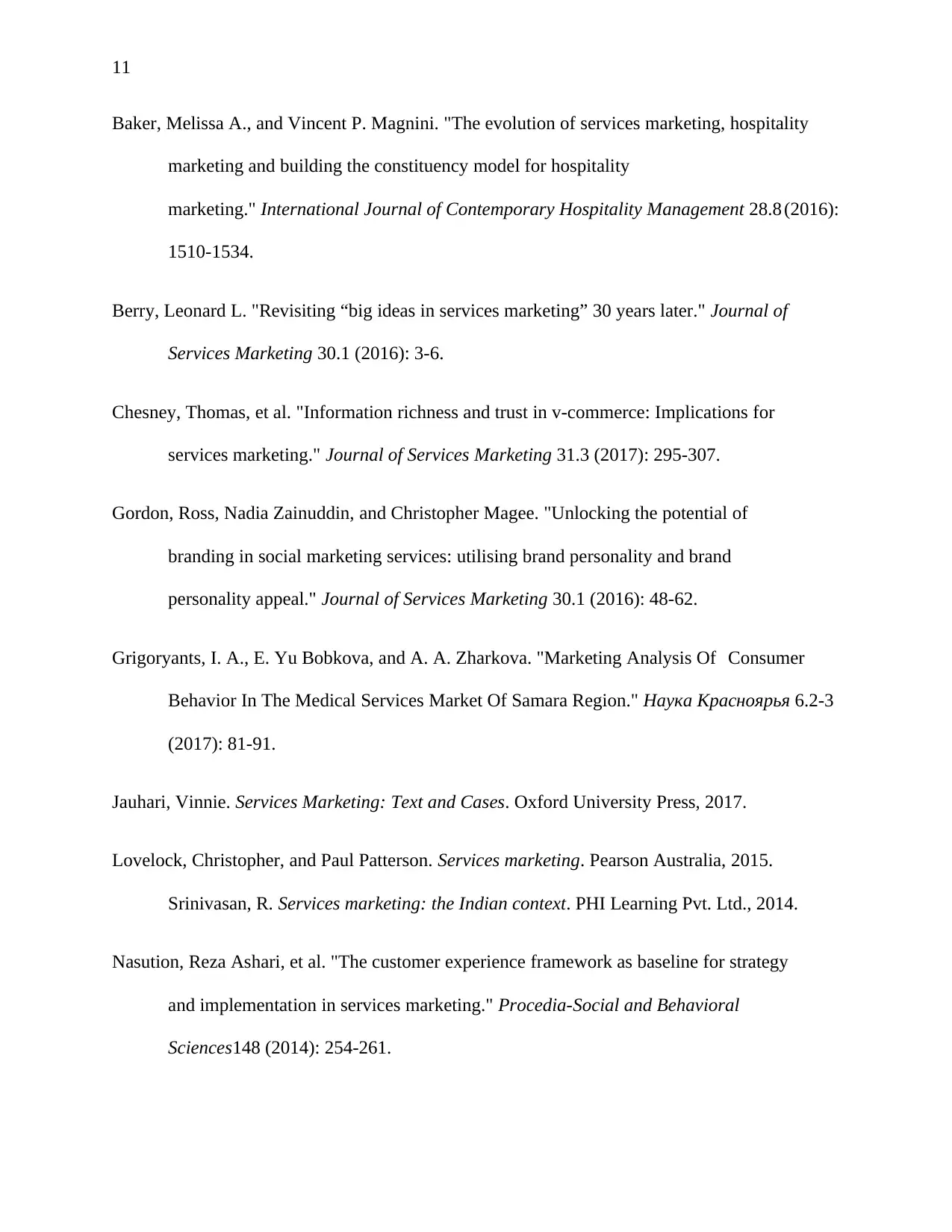
11
Baker, Melissa A., and Vincent P. Magnini. "The evolution of services marketing, hospitality
marketing and building the constituency model for hospitality
marketing." International Journal of Contemporary Hospitality Management 28.8 (2016):
1510-1534.
Berry, Leonard L. "Revisiting “big ideas in services marketing” 30 years later." Journal of
Services Marketing 30.1 (2016): 3-6.
Chesney, Thomas, et al. "Information richness and trust in v-commerce: Implications for
services marketing." Journal of Services Marketing 31.3 (2017): 295-307.
Gordon, Ross, Nadia Zainuddin, and Christopher Magee. "Unlocking the potential of
branding in social marketing services: utilising brand personality and brand
personality appeal." Journal of Services Marketing 30.1 (2016): 48-62.
Grigoryants, I. A., E. Yu Bobkova, and A. A. Zharkova. "Marketing Analysis Of Consumer
Behavior In The Medical Services Market Of Samara Region." Наука Красноярья 6.2-3
(2017): 81-91.
Jauhari, Vinnie. Services Marketing: Text and Cases. Oxford University Press, 2017.
Lovelock, Christopher, and Paul Patterson. Services marketing. Pearson Australia, 2015.
Srinivasan, R. Services marketing: the Indian context. PHI Learning Pvt. Ltd., 2014.
Nasution, Reza Ashari, et al. "The customer experience framework as baseline for strategy
and implementation in services marketing." Procedia-Social and Behavioral
Sciences148 (2014): 254-261.
Baker, Melissa A., and Vincent P. Magnini. "The evolution of services marketing, hospitality
marketing and building the constituency model for hospitality
marketing." International Journal of Contemporary Hospitality Management 28.8 (2016):
1510-1534.
Berry, Leonard L. "Revisiting “big ideas in services marketing” 30 years later." Journal of
Services Marketing 30.1 (2016): 3-6.
Chesney, Thomas, et al. "Information richness and trust in v-commerce: Implications for
services marketing." Journal of Services Marketing 31.3 (2017): 295-307.
Gordon, Ross, Nadia Zainuddin, and Christopher Magee. "Unlocking the potential of
branding in social marketing services: utilising brand personality and brand
personality appeal." Journal of Services Marketing 30.1 (2016): 48-62.
Grigoryants, I. A., E. Yu Bobkova, and A. A. Zharkova. "Marketing Analysis Of Consumer
Behavior In The Medical Services Market Of Samara Region." Наука Красноярья 6.2-3
(2017): 81-91.
Jauhari, Vinnie. Services Marketing: Text and Cases. Oxford University Press, 2017.
Lovelock, Christopher, and Paul Patterson. Services marketing. Pearson Australia, 2015.
Srinivasan, R. Services marketing: the Indian context. PHI Learning Pvt. Ltd., 2014.
Nasution, Reza Ashari, et al. "The customer experience framework as baseline for strategy
and implementation in services marketing." Procedia-Social and Behavioral
Sciences148 (2014): 254-261.
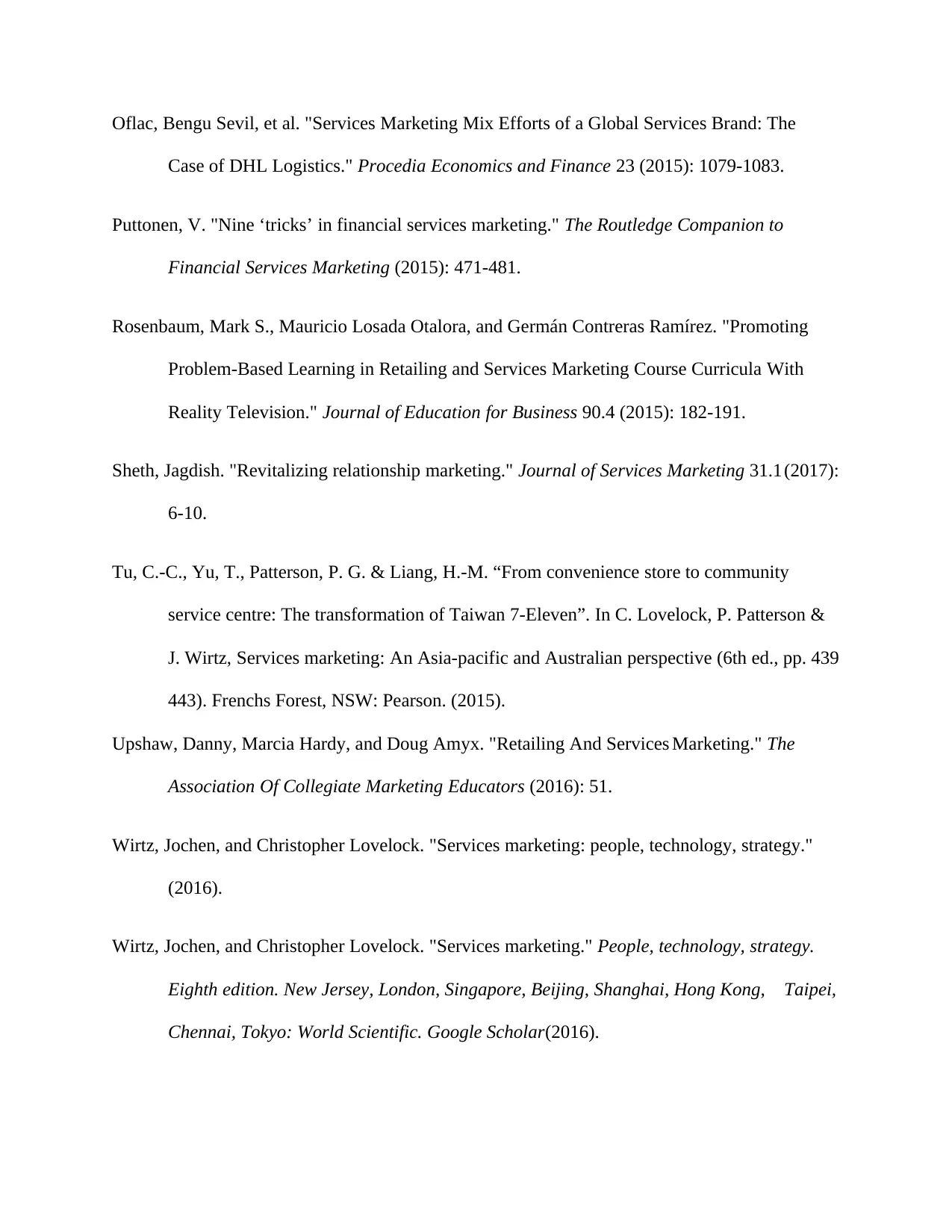
Oflac, Bengu Sevil, et al. "Services Marketing Mix Efforts of a Global Services Brand: The
Case of DHL Logistics." Procedia Economics and Finance 23 (2015): 1079-1083.
Puttonen, V. "Nine ‘tricks’ in financial services marketing." The Routledge Companion to
Financial Services Marketing (2015): 471-481.
Rosenbaum, Mark S., Mauricio Losada Otalora, and Germán Contreras Ramírez. "Promoting
Problem-Based Learning in Retailing and Services Marketing Course Curricula With
Reality Television." Journal of Education for Business 90.4 (2015): 182-191.
Sheth, Jagdish. "Revitalizing relationship marketing." Journal of Services Marketing 31.1 (2017):
6-10.
Tu, C.-C., Yu, T., Patterson, P. G. & Liang, H.-M. “From convenience store to community
service centre: The transformation of Taiwan 7-Eleven”. In C. Lovelock, P. Patterson &
J. Wirtz, Services marketing: An Asia-pacific and Australian perspective (6th ed., pp. 439
443). Frenchs Forest, NSW: Pearson. (2015).
Upshaw, Danny, Marcia Hardy, and Doug Amyx. "Retailing And Services Marketing." The
Association Of Collegiate Marketing Educators (2016): 51.
Wirtz, Jochen, and Christopher Lovelock. "Services marketing: people, technology, strategy."
(2016).
Wirtz, Jochen, and Christopher Lovelock. "Services marketing." People, technology, strategy.
Eighth edition. New Jersey, London, Singapore, Beijing, Shanghai, Hong Kong, Taipei,
Chennai, Tokyo: World Scientific. Google Scholar(2016).
Case of DHL Logistics." Procedia Economics and Finance 23 (2015): 1079-1083.
Puttonen, V. "Nine ‘tricks’ in financial services marketing." The Routledge Companion to
Financial Services Marketing (2015): 471-481.
Rosenbaum, Mark S., Mauricio Losada Otalora, and Germán Contreras Ramírez. "Promoting
Problem-Based Learning in Retailing and Services Marketing Course Curricula With
Reality Television." Journal of Education for Business 90.4 (2015): 182-191.
Sheth, Jagdish. "Revitalizing relationship marketing." Journal of Services Marketing 31.1 (2017):
6-10.
Tu, C.-C., Yu, T., Patterson, P. G. & Liang, H.-M. “From convenience store to community
service centre: The transformation of Taiwan 7-Eleven”. In C. Lovelock, P. Patterson &
J. Wirtz, Services marketing: An Asia-pacific and Australian perspective (6th ed., pp. 439
443). Frenchs Forest, NSW: Pearson. (2015).
Upshaw, Danny, Marcia Hardy, and Doug Amyx. "Retailing And Services Marketing." The
Association Of Collegiate Marketing Educators (2016): 51.
Wirtz, Jochen, and Christopher Lovelock. "Services marketing: people, technology, strategy."
(2016).
Wirtz, Jochen, and Christopher Lovelock. "Services marketing." People, technology, strategy.
Eighth edition. New Jersey, London, Singapore, Beijing, Shanghai, Hong Kong, Taipei,
Chennai, Tokyo: World Scientific. Google Scholar(2016).
⊘ This is a preview!⊘
Do you want full access?
Subscribe today to unlock all pages.

Trusted by 1+ million students worldwide
1 out of 12
Related Documents
Your All-in-One AI-Powered Toolkit for Academic Success.
+13062052269
info@desklib.com
Available 24*7 on WhatsApp / Email
![[object Object]](/_next/static/media/star-bottom.7253800d.svg)
Unlock your academic potential
Copyright © 2020–2025 A2Z Services. All Rights Reserved. Developed and managed by ZUCOL.



